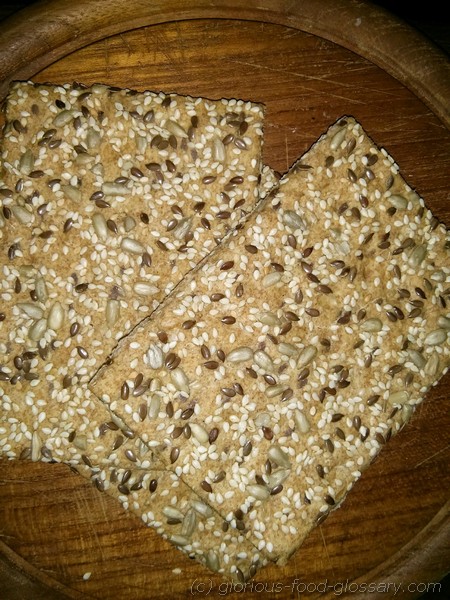The Glorious Food Glossary
The Glorious Food Glossary tells you everything important about the world of food. The Food Glosssary is all about different kinds of food from all over the world and how they are prepared and what their main ingredients are.
Moreover, the glossary is all about what people all over the world are eating and drinking and their activities, festivities, marriages, etc that involves food.
This Food Glossary is all about food . . . glorious food. We tell you about the food, some stories about them and we try our best to make photos of them as we travel around the world. As of now, we are featuring extensively foods from Germany, the Philippines and the State of Kerala, India, but we will add more pictures for you to enjoy as we discover the food of the world... as we travel around the globe.
All articles are available through the search function or via the A to Z line at the top of every page.
Knäcke (Knaecke)
Knäcke (Knaecke) also called Knäckebrot (Knaeckebrot) refers to crisp or crispy bread. In Germany, they can be bought in plastic packs with at least 6 pieces plain or with assorted nuts, like white and black sesame seeds, poppy seeds, pine nuts or pumpkin nuts or mixed nuts, like the one in the picture below.

Culinary Use
Deutsch: Kulinarische Verwendung / Español: Uso culinario / Português: Uso culinário / Français: Usage culinaire / Italiano: Uso culinario
The term Culinary Use refers to the application of ingredients, techniques, and tools in the preparation, cooking, and presentation of food for consumption. It encompasses both traditional practices and innovative approaches that define the sensory and nutritional qualities of dishes. Culinary use is not merely about functionality but also about cultural expression, sustainability, and the interplay between science and art in gastronomy.
Environmental Concerns
Deutsch: Umweltbedenken / Español: Preocupaciones ambientales / Português: Preocupações ambientais / Français: Préoccupations environnementales / Italiano: Preoccupazioni ambientali
Environmental Concerns in the context of food refer to the negative impacts that agricultural practices, food production, distribution, and consumption have on ecosystems, natural resources, and climate stability. These concerns encompass a broad spectrum of issues, including greenhouse gas emissions, biodiversity loss, water scarcity, soil degradation, and pollution, all of which are exacerbated by global food systems. Addressing these challenges is critical for ensuring long-term food security, public health, and ecological sustainability.
Nutrition
Deutsch: Ernährung / Español: Nutrición / Português: Nutrição / Français: Nutrition / Italiano: Nutrizione
Nutrition is the scientific study of how organisms obtain and utilize nutrients from food to sustain life, growth, and health. It encompasses the biochemical and physiological processes that convert food into energy and structural components, while also addressing the dietary requirements necessary for optimal bodily function. Nutrition plays a pivotal role in preventing disease, promoting longevity, and maintaining overall well-being across all stages of life.
Health Concerns
Deutsch: Gesundheitsbedenken / Español: Preocupaciones por la salud / Português: Preocupações com a saúde / Français: Préoccupations sanitaires / Italiano: Preoccupazioni per la salute
In the context of food, Health Concerns refer to potential risks or adverse effects associated with the consumption, production, or handling of food products. These concerns encompass a broad spectrum of issues, ranging from immediate health hazards like foodborne illnesses to long-term effects such as chronic diseases or nutritional imbalances. The evaluation of health concerns in food is a multidisciplinary field, integrating toxicology, microbiology, nutrition science, and regulatory frameworks to ensure food safety and public health.
